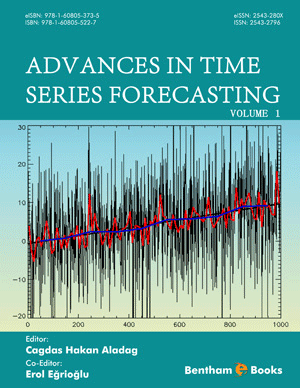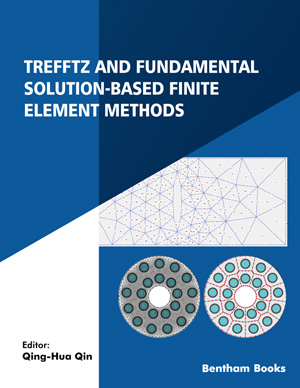Solving Fractional Diffusion Equation by Wavelet Methods
Page: 1-32 (32)
Author: Zhijiang Zhang and Weihua Deng
DOI: 10.2174/9781681085999118010004
PDF Price: $15
Abstract
The wavelet numerical methods for solving the classic differential equations have been well developed, but their application in solving fractional differential equations is still in its infancy. In this chapter we tentatively investigate the advantages of the spline wavelet basis functions in solving the fractional PDEs. Our contributions are as follows: 1. the techniques of efficiently generating stiffness matrix with computational cost
A Survey on the Recent Results Regarding Maximum Principles for the Time-Fractional Diffusion Equations
Page: 33-69 (37)
Author: Yuri Luchko and Masahiro Yamamoto
DOI: 10.2174/9781681085999118010005
PDF Price: $15
Abstract
In this chapter, a survey on the recent results regarding the maximum principles for the time-fractional diffusion equations is presented. We formulate the maximum principles for the time-fractional partial differential equations with both the Caputo fractional derivative and the Riemann-Liouville fractional derivative. Along with the single-term time-fractional differential equations, the multi-term equations and the equations of the distributed order are considered. We also discuss some important applications of the maximum principles for the time-fractional diffusion equations including a priori estimates for solutions of the initial-boundaryvalue problems for these equations and uniqueness of their solutions.
Integral-Balance Solution to Nonlinear Subdiffusion Equation
Page: 70-105 (36)
Author: Jordan Hristov
DOI: 10.2174/9781681085999118010006
PDF Price: $15
Abstract
Improved double-integration technique to approximate integral-balance solutions of non-linear fractional subdiffusion equations has been conceived. The time-fraction subdiffusion equation with Dirichlet boundary condition and a powerlaw fractional diffusivity has been chosen as a test example. Problems pertinent to approximation of time-fractional Riemann-Liouville derivative when the distribution is expressed as a parabolic profile with unspecified exponent and accuracy of the solutions have been analyzed. The final solution is a closed-form can be presented with either a similarity variable of a fractional order as independent variable or by an effective similarity variable incorporating the effects of both the fractional order and the nonlinearity of the diffusion coefficient. Optimization problem pertinent to determination of the optimal exponent of the parabolic profile, dependent on both the fractional order and the nonlinearity parameter of the diffusion coefficient, has been developed by a modified technique transforming the time-varying domain of integration into one with fixed boundaries. It was clearly defined that the approximate profile can exhibit a concave behaviour, typical for subdiffusion relaxation processes when the non-linearity of the diffusion coefficient is low and the fractional order is high. Otherwise, the increase in the nonlinearity of the diffusion coefficient results in convex profiles typical for the degenerate diffusion behaviour.
Analysis of Solution and System Identification of Coupled Fractional Delay Differential Equation by Shifted Jacobi Polynomials
Page: 106-131 (26)
Author: B. Ganesh Priya, P. Muthukumar and P. Balasubramaniam
DOI: 10.2174/9781681085999118010007
PDF Price: $15
Abstract
This chapter is concerned with a class of linear delay differential equation with two fractional orders. Based on the shifted Jacobi operational matrix method, the numerical approximate solution as well as the parameters estimation for the proposed system are obtained. The maximum error bounds of approximate solution and operational matrix for fractional integration are analyzed. The main results are illustrated with suitable examples.
Monotone Iteration Principle in the Theory of Hadamard Fractional Delay Differential Equations
Page: 132-158 (27)
Author: Kishor D. Kucche
DOI: 10.2174/9781681085999118010008
PDF Price: $15
Abstract
This chapter deals with the existence, uniqueness and approximations of solutions of Hadamard fractional delay differential equations and neutral Hadamard fractional delay differential equations. The results are acquired via monotone iteration principle and hybrid fixed point theorems established by Dhage (2014) in partially ordered normed linear spaces (PONLS) by imposing weak conditions on the functions involved in the equations like mixed partial continuity and partial compactness or partial Lipschitz conditions.
Dynamics of Fractional Order Modified Bhalekar- Gejji System
Page: 159-182 (24)
Author: Sachin Bhalekar
DOI: 10.2174/9781681085999118010009
PDF Price: $15
Abstract
In the present chapter, we study the dynamics of modified Bhalekar-Gejji system. We discuss the stability, symmetry, dissipativity and chaos in the proposed system. We control the chaos using linear feedback control and synchronize the system with new chaotic system using active control.
Grunwald-Letnikov Derivative: Analysis in Range of First Order
Page: 183-198 (16)
Author: Radosław Cioc
DOI: 10.2174/9781681085999118010010
PDF Price: $15
Abstract
This chapter analyses Grünwald-Letnikov
GPU Computing of Special Mathematical Functions used in Fractional Calculus
Page: 199-232 (34)
Author: Parag Patil, Navin Singhaniya, Chaitanya Jage, Vishwesh A. Vyawahare, Mukesh D. Patil and P.S.V. Nataraj
DOI: 10.2174/9781681085999118010011
PDF Price: $15
Abstract
Fractional calculus is a field with growing interest for researchers due to its applications in the various fields like mathematical modeling, control systems, image processing, financial systems, etc. Special mathematical functions like Gamma functions, Mittag-Leffler function, Hypergeometric function, etc. play a crucial role in the analytical and numerical solutions of fractional differential equations. However, the numerical computation of these functions is a tedious and time-consuming task. This is due to the fact that these functions do not have straightforward definitions and are mostly represented by series expansions. This chapter attempts to exploit the parallel computing power of Graphics Processing Unit (GPU) for computing some of the well-known special functions used in fractional calculus. Using the numerical computational platform of MATLAB and its parallel computing toolbox, the chapter reports the use of GPU hardware to compute these functions using their series definitions. It is shown with the help of various case studies and for different parameter combinations that the implementation of parallel computation of special functions reduces the execution time. A comparative study showing the effect of function parameters on their parallel computation is also presented.
New Iterative Method: A Review
Page: 233-268 (36)
Author: Varsha Daftardar-Gejji and Manoj Kumar
DOI: 10.2174/9781681085999118010012
PDF Price: $15
Abstract
In this article we provide a comprehensive review of new iterative method (NIM) proposed by Daftardar-Gejji and Jafari [1]. This method is useful for solving functional equation of the form
Derivatives with Non-Singular Kernels from the Caputo-Fabrizio Definition and Beyond: Appraising Analysis with Emphasis on Diffusion Models
Page: 269-341 (73)
Author: Jordan Hristov
DOI: 10.2174/9781681085999118010013
PDF Price: $15
Abstract
This chapter presents an attempt to collate existing data about fractional derivatives with non-singular kernels conceived by Caputo and Fabrizio in 2015. The idea attracted immediately the interest of the researcher and the text encompasses the consequent developments of the idea with new derivatives of Riemann-Liouville type and the generalization with kernels expressed by the Mittag-Leffler function. The chapter especially stresses the attention on diffusion equations where the Caputo-Fabrizio time-fractional derivative naturally appears as a relaxation term when the constitutive equation relating the flux and the gradient contains either Cattaneo exponential kernel or Jeffrey kernel. Four models are considered demonstrating the technology of diffusion model derivation. A special section is devoted to a spatial derivative of Caputo-type with exponential nonsingular kernel for materials exhibiting spatial memory. Critical comments and suggestions are devoted to the formalistic fractionalization approach and the outcomes of this reasonless operation.
Fractional Order Nonlinear Systems: Some Open Problems in Numerical Computations and Chaos Theory
Page: 342-347 (6)
Author: Sachin Bhalekar
DOI: 10.2174/9781681085999118010014
PDF Price: $15
Abstract
In this chapter, we discuss some open problems in the theory of nonlinear fractional order systems. We emphasize on the open issues related to numerical computations and chaos in such systems.
Introduction
This book brings together eleven topics on different aspects of fractional calculus in a single volume. It provides readers the basic knowledge of fractional calculus and introduces advanced topics and applications. The information in the book is presented in four parts: 1. Fractional Diffusion Equations: (i) solutions of fractional diffusion equations using wavelet methods, (ii) the maximum principle for time fractional diffusion equations, (iii) nonlinear sub-diffusion equations. 2. Mathematical Analysis: (i) shifted Jacobi polynomials for solving and identifying coupled fractional delay differential equations, (ii) the monotone iteration principle in the theory of Hadamard fractional delay differential equations, (iii) dynamics of fractional order modified Bhalekar-Gejji System, (iv) Grunwald-Letnikov derivatives. 3. Computational Techniques: GPU computing of special mathematical functions used in fractional calculus. 4. Reviews: (i) the popular iterative method NIM, (ii) fractional derivative with non-singular kernels, (iii) some open problems in fractional order nonlinear system This is a useful reference for researchers and graduate level mathematics students seeking knowledge about of fractional calculus and applied mathematics.












